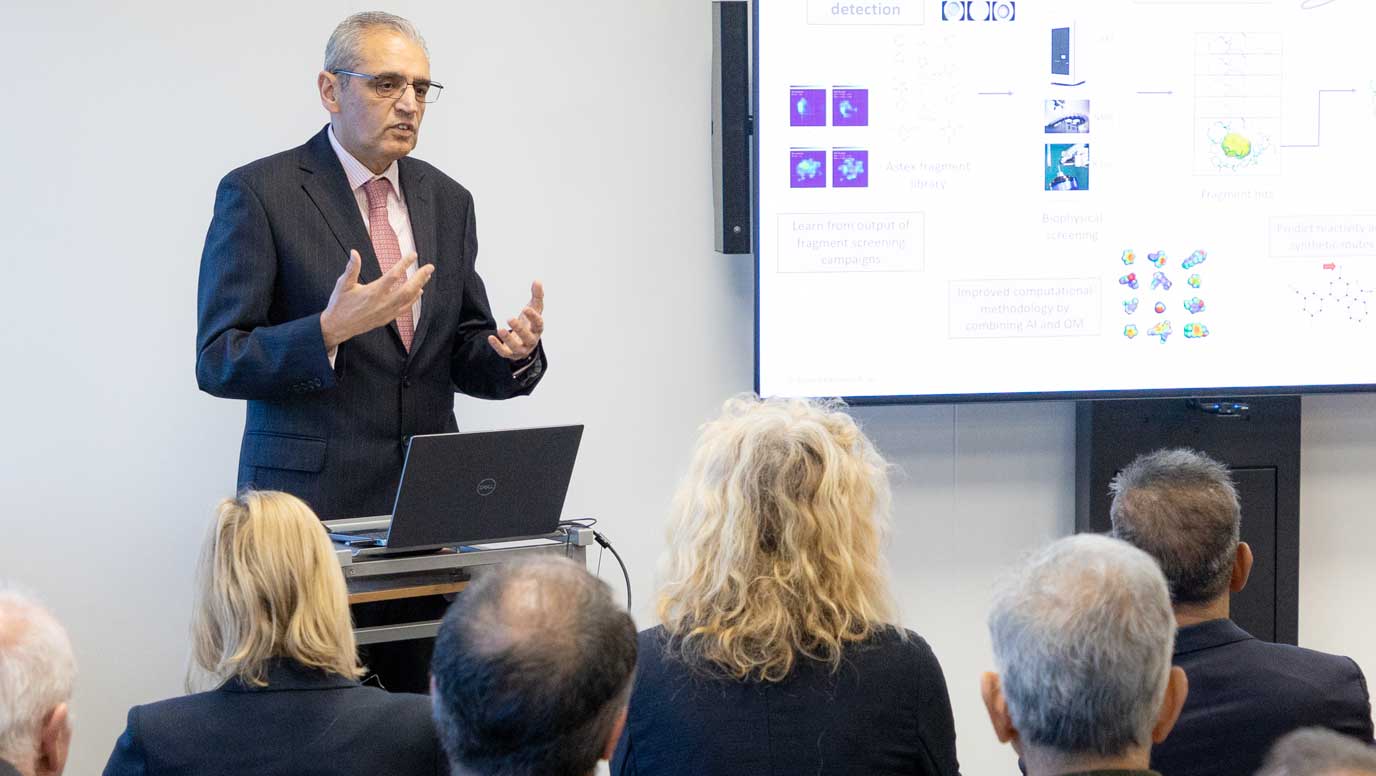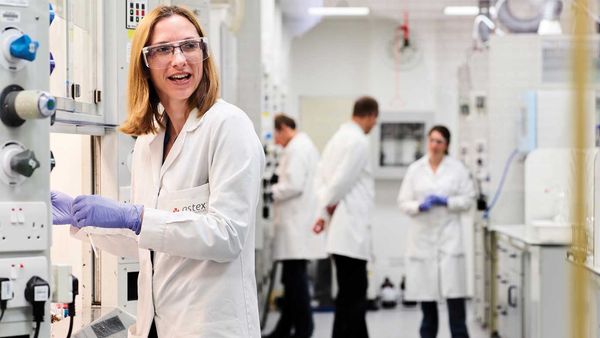Solid gold future as Astex pursues further growth in wake of silver jubilee

But as co-founder, President and CEO Dr Harren Jhoti explains, there will be no taking time out to polish the corporate silver as the company absorbs its wonderful 2024 anniversary milestone.
Astex is combing Cambridge for a new R & D facility, which may or may not be at the Science Park, as it keeps open its options. The aim of the new site is to facilitate growth and to bring all employees in the company under one roof. Expansion will be baked in as there will probably be a modest number of new hires in the months and years to come.
There will inevitably be fresh successes for its three most successful partnered drugs, one of which is already a blockbuster and is set to reach stunning new heights in the next couple of years.
But rather than risk over-reaching its capabilities, Astex continues to pursue a laser-focused, steady-as-you-go philosophy – all the while expanding its horizons at a sedate but sure-footed pace.
As we chewed the cud, meandering across pastures old and new, it was apparent that Astex had stayed remarkably true to its roots. Dr Jhoti recalled initial heads2head with co founders Chris Abel and Tom Blundell before Astex opened its doors and in the early days following launch and reckons little has changed in terms of the company philosophy.
Astex has been a subsidiary of Japanese giant Otsuka for more than 11 years now so this is a fitting approach: There’s a Japanese proverb that says: ‘Chiri mo tsumoreba yama to naru.’ Basically, ‘If dust piles up, it will become a mountain.’ Tiny actions built on over time can lead to unexpectedly large and significant results.
Dr Jhoti says Tokyo-based Otsuka has been a wonderfully patient and powerful parent and ally, allowing Astex to take its time pursuing opportunities generated from its innovative technology and ultimately perfecting them to the benefit of millions of disease sufferers worldwide.
Back to the Future? Not exactly. Astex remains dedicated to progress in terms of physical growth and global influence.

For those sheltered souls who may not know, Astex is a leader in innovative drug discovery and development – committed to the fight against cancer and diseases of the central nervous system (CNS).
Astex genuinely pioneered fragment-based drug discovery (FBDD), a technique now widely used in the industry, and built a rich pipeline of drugs in preclinical and clinical development.
Its partnerships with major UK research institutes and international pharmaceutical companies have so far led to three marketed cancer drugs that are now helping patients worldwide, namely Kisqali®, a blockbuster drug, Balversa® and Truqap®.
Kisqali® is a trademark of Novartis AG. Balversa® a trademark of Janssen Biotech, Inc., a company that is part of Johnson & Johnson. Truqap® is a trademark of AstraZeneca.
A blockbuster drug generates annual sales of $1 billion and life science experts reckon Kisqali® could be making $8bn annually in the next couple of years.
Market speculation isn’t bothering Astex too much right now as it focuses on the next generation of potential cures for cancer and CNS diseases being suffered worldwide.
Dr Jhoti says: “We are very excited that Novartis continues to develop Kisqali® and that Janssen and AstraZeneca are doing likewise but we also have to look at our own existing pipeline in terms of other drugs and how these might be progressed.
“We are also encouraged by progress being made with our current pharma partner, MSD, targeting so far untapped mechanisms in cancer.”
The bio world is currently obsessed with finding cures for ageing conditions although big funding is going into neurodegenerative diseases with the Gates Foundation backing Cambridge plays in the area of Parkinson’s Disease and other investors funding similar initiatives to fight Alzheimer’s.
Astex has a broad pipeline and has no need to rush into diversified areas of activity. It also has what Dr Jhoti calls an almost “brutal focus” on its own areas of expertise. This is reflected in its shrewd recruitment strategy and staff retention as well as its measured portfolio.

He talks about self-discipline and Business Weekly certainly sees this as one of the company’s greatest strengths. We too often see life science – and tech tyros – not so much pivoting as pirouetting in terms of the research they pursue and endeavour to fund.
Dr Jhoti feels that the vast majority of the Cambridge life science cluster benefits from excellent science and shrewd deployment in terms of exploiting it – whether that be stand alone or, as is more often the case, with global pharma partners.
And one of the Cambridge cluster’s great strengths is its academic backdrop, he believes. Dr Jhoti hails organisations such as the LMB and the apparently endemic approach one often sees from academics liaising with life science companies.
The level of freedom enjoyed by leading academics, their entrepreneurial spirit and willingness to explore the art of the possible – to keep pushing back boundaries – have all helped underpin the efforts of biotechs in Cambridge and the UK to search for and commercialise cures for a whole host of diseases.
Their efforts, of course, are benefiting sufferers the whole world over. “Academics collaborating with life sciences researchers from industry have had a massive impact on healthcare,” Dr Jhoti remarks. “Collaboration has always been in our DNA at Astex.”
Astex is a prime example as far as beneficiaries of collaboration go. But it also benefits from superb market nous. The company currently has two separate offices across the road from each other at the Science Park, which isn’t ideal.
Dr Jhoti says: “We are in the early stages of identifying a possible new R & D location and facility. But making that choice may take five or six years before we move in, to get things absolutely right. We may stay on the Science Park or choose one of the many other locations Cambridge has to offer companies such as ours.
“It would be nice if all of us were under one roof – we currently have around 200 people at the two sites – and are very happy here but the Cambridge life sciences ecosystem is rich in choice of location and likely to become even more so. There is no pressure to make a hasty decision.”
Dr Jhoti is also enthused by government plans to engender an even wider sense of collaboration between science & tech entrepreneurs and companies, across the Cambridge-Oxford corridor and even wider afield.
Astex has a collaboration in the area of quantum computing (QC) with Cambridge based Riverlane, a spin-out from the computational mathematics department at the University of Cambridge.

As he told Lord Vallance and selected life science executives at its recent 25th anniversary summit: “As scientists, we hope that our discoveries will make a difference to patients and as entrepreneurs we strive to build sustainable companies to translate those discoveries into significant new medicines. The Astex team is fortunate to have achieved both goals.
“The company has also greatly benefited from the growth and development of the UK life sciences sector in the last 25 years into a leading international powerhouse and the very strong culture of innovation and entrepreneurship in Cambridge.
“Looking forward to the next 25 years, we will continue investing in the Cambridge life sciences ecosystem by establishing a brand-new R & D facility and championing open innovation and discovery through collaboration.
“Products we discover in-house and in partnership with academic partners, have the opportunity to be developed and commercialised through operating subsidiaries within the Otsuka group in the major markets worldwide and through selective strategic collaborations with pharma partners globally.”
There are life science companies locally with fatter wallets and more global offices but relatively few that possess the sustained quality that Astex displays through its pipeline and its people. Scientific advancement is food and drink to the whole team. There are no champagne Charlies or one-hit wonders here.


